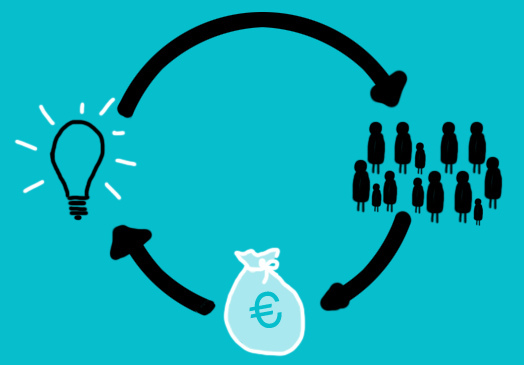Franchising, retail, business

16/05/2014
In San Francisco, Teresa Goines is breaking down deeply entrenched cycles of poverty and crime, one bowl of peanut butter stew at a time. Old Skool Café, the 1940’s supper club she started, gives jobs to at-risk and former gang youth. When banks turned her down, 41 people she’d never met crowdfunded a $5000 loan, putting their faith and money in Teresa, a former corrections officer with no restaurant experience in a city where most new restaurants fail. Their bet paid off. She repaid her loan in full. Each year, 25 troubled young people, most who have tangled with the law, get their lives back on track. Today, Teresa has an even bigger dream of opening Old Skool Cafes across the nation and revitalizing communities everywhere.
As high-tech investors, both of us obviously value high-impact, fast-growth companies that attract massive global user bases. Such companies can scale quickly, create thousands of jobs, and help the U.S. improve its export economy at a time when its share of global economic output is falling. But we also recognize that most businesses are small businesses. Indeed, out of the roughly 27 million businesses in the U.S., 21 million of them have no employees – they’re sole proprietorships. And approximately 4.6 million of the 5.9 million businesses that do have employees have nine or fewer.
Thus, small businesses are a crucial component of the American economy. Yet when people like Teresa Goines try to create new businesses and jobs, banks shy away. According to Biz2Credit, an online devoted to small business funding, big banks currently reject more than 8 out of 10 loan applicants, and small banks reject 5 out of 10. Some estimates suggest that investment in small businesses has dropped as much as 44 percent since the Great Recession in 2008. That's tens of billions of dollars that fueled the economy and helped our communities thrive – gone, completely eviscerated. Meanwhile, twenty-one million people are underemployed or unemployed. Globally, it’s far worse, with half the planet’s population living on less than $2 a day.
While talent is universal, opportunity is not – even in the land of opportunity. The greatest threat to our long-term prosperity goes far beyond the financial crisis and the health of a few banks on Wall Street that have been deemed “too big to fail.” The real threat we face is a global opportunity crisis. In both the developing and the developed world, billions of people don’t have access to jobs and capital.
That’s why we’re on the board at Kiva, the pioneering crowdfunding platform where citizen lenders invest small sums in micro-entrepreneurs all over the world. Nearly 1.3 million borrowers like Teresa Goines, living in 76 countries, including the U.S., have received more than half a billion dollars in loans. 99% of these loans have been repaid in full, flying in the face of traditional banking assumptions about credit and trust.
Kiva is no longer unique. Today, an exploding crowdfunding sector is making billions of dollars of capital accessible to upstarts and entrepreneurs. Over 700 crowdfunding marketplaces, led by the likes of IndieGogo, Kickstarter, and Lending Club, are democratizing access to capital, fueling entrepreneurship and innovation, and profoundly changing the face of philanthropy at unprecedented scale and impact.
Citizens Lenders Democratizing Access to Capital
One of the best ways to fuel widespread prosperity is by helping Main Street invest in itself. Crowdfunding relies on the wisdom of crowds to identify fund and unleash entrepreneurial innovation far more efficiently than the credit rules of banks can.
Call it the emergence of a “world's bank” – a system built by and for the people, delivering credit in America and across the globe in a radically decentralized, highly scalable, and crucially equitable way.
The World Bank funds institutions. The world's bank funds people. For decades, the World Bank has existed as a top-down mechanism to spur economic growth in developing nations. In contrast, the world’s bank picks up with a nimble, bottoms-up model that is far more attuned to on-the-ground needs of micro-entrepreneurs and their communities worldwide.
The motivations for citizen-lenders run the gamut from altruistic to creative to financial. Kickstarter and IndieGogo funders typically get some type of reward in return for their capital. Kiva lenders are paid back by micro-entrepreneurs, albeit with no interest. Services like Lending Club offer lenders a way to earn interest on personal loans.
In the same way that citizen journalists have shaken up Old Media, citizen lenders may upend Old Banking. Already, Lending Club has made $4 billion in personal loans in the U.S. alone. Kickstarter lenders have applied over $1 billion to more than 60,000 projects in just five years. More than 60 projects obtained at least $1 million in funding, and one attracted over $10 million. There are over 1 million Kiva lenders residing in 198 countries. Finally, a new change in federal regulations has opened the market for equity crowdfunding, further empowering innovative entrepreneurs via marketplaces like AngelList and CrowdFunder.
Still, it’s easy to underestimate the impact of crowdfunding, dismissing these purpose-driven marketplaces as a simplistic way for do-gooders to easily support pet causes, yet incapable of driving massive structural change that can improve prosperity for all, not just a select few. The opposite is true.
The Surprising Sophistication of Crowdfunding Platforms
Crowdfunding can easily go where traditional banks cannot. Take Erastus Kimani, a 73 year old schoolteacher turned entrepreneur, who lives in a remote part of Kenya without indoor plumbing, much less indoor banking. Erastus attracted lenders from all over the world. They crowdfunded $1700 which allowed him to triple the production of his ceramic stove liner business. Using just his mobile phone, Erastus applied for, received, and paid back his loans in full. He did it all without bank officers, ATMs, or even a computer.
More broadly, crowdfunding is a sophisticated and pragmatic expression of democratic values and ideals. It recognizes that person-to-person connections are the essential fuel that powers the Internet. Just as Old Media behemoths struggle to keep up with the growth of people-powered content, traditional financial institutions can’t scale like crowdfunding platforms can. Imagine what it would cost a traditional bank to hire enough loan officers to match the network intelligence that millions of citizen lenders provide.
As technology continues to virtualize money, brick ‘n mortar banks have become as superfluous as traditional bookstores. Ornate buildings designed to convey trust and dependability just make loans look more costly. Meanwhile, the world’s bank lending infrastructure is increasingly made up of people like Erastus Kimani and his mobile phone. His status as a dependable borrower qualified him to join a growing network of trustees and vouch for other micro-entrepreneur borrowers in his village of Maragua, Kenya.
Networks of Trust
Remember George Bailey from It’s a Wonderful Life, the small-town banker who helped local entrepreneurs achieve self-sufficiency and resilience? Or the stories of Bank of America founder A.P. Giannini, who in the wake of San Francisco's devastating 1906 earthquake and fire famously made loans to distraught home and business owners on the basis of a handshake?
Crowdfunding multiplies George Bailey and A.P. Giannini. It uses early 21st century technology to return us to early 20th century ideals of loyalty, reciprocity, and community. The result is highly efficient trust networks based on reputation. It replaces credit score-based lending by faceless institutions with a person to person character-based lending model. It creates connections and stories that intermediary institutions are hard-pressed to facilitate. 34 individuals put their faith in Erastus Kimani. Not surprisingly, he paid back both of his loans in full.
Wall Street is evermore focused on creating increasingly exotic, abstract, and toxic instruments of speculation with little to no societal benefit. Our financial institutions are becoming less and less tied to producing tangible goods and services. In contrast, crowdfunding re-humanizes our economy. It makes the act of lending more fulfilling for both lenders and borrowers, brings meaning to commerce, and creates tangible social and economic value at a mass scale.
Philanthropy Exponentialized
While many traditional attempts to address poverty often set up recipients for a vicious cycle of dependency, crowdfunding platforms tie opportunity to innovation, accountability, and self-reliance. They create an ecosystem where debt, applied to entrepreneurial ends rather than mere consumption, can create value for people rather than simply becoming a millstone around their necks.
In the case of Kiva, lenders invest again when their loans are repaid. Over time, $25 has the impact of $250. $100,000 has the impact of $1 million. $1 million has the impact of $10 million. It’s philanthropy exponentialized.
Google and a growing number of companies and results-driven philanthropists have begun creating multi-million-dollar evergreen loan funds that are tapping the power of this leverage. Imagine if the Small Business Association, the Fortune 500, the World Bank, and even Wall Street followed suit and began directly supporting those three billion overlooked micro-entrepreneurs like Erastus Kimani and Teresa Goines through the world’s bank movement. It would profoundly accelerate our quest to end the global opportunity crisis.
Every technology revolution has its early adopters and its laggards. The early adopters fueling the world’s bank and democratizing access to capital understand that the true path to prosperity lies in recognizing the critical role that micro-entrepreneurs and small businesses play in establishing healthy and resilient economies. They understand that crowdfunding starts with individuals but quickly scales. First, it changes a borrower's life. Then, a family's. Then, a community's. Finally, it changes the fate of nations.
Fonte: insideretail.asia